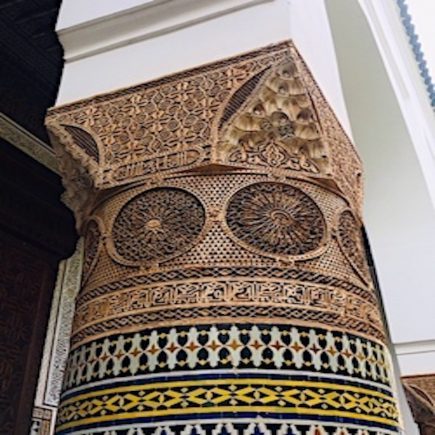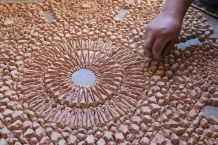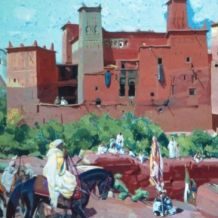Morocco is known for its extraordinary architecture that has historically been influenced by Moors and the Idrisi dynasty whose geometric designs and patterns were incorporated in all forms of buildings. Pre Islamization the Berber Kingdom set the architectural tone with mud-brick houses and kasbahs. Touring Morocco’s Imperial Cities and the grand south offers the opportunity to discover hidden treasures from 110 BC and 11 extraordinary places to see were Islamic Design & Geometric Patterns can be found.
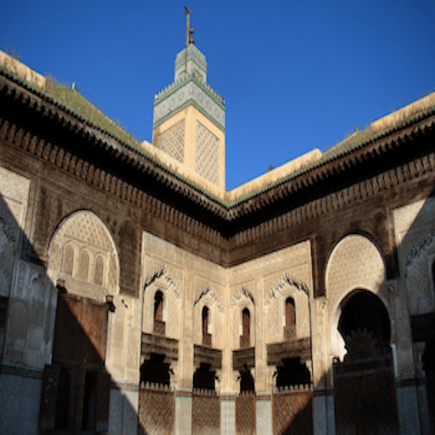
1. Dar Si Said Museum (Marrakech, Medina)
Dar Si Said, (The Museum of Moroccan Arts) was once the private home of the brother of Bou-Ahmed, Sisi Said. A large courtyard with a traditional fountain laid out in classic Moroccan style surround each room. Dari Sais boasts hand-carved and painted ceilings on the top floor which are perhaps one of the finest examples of painted ceilings from this error in Marrakech.
The Dar Si Said museum’s collection is said to be one of the finest in Morocco. The museum is an Islamic architectural masterpiece and showcases jewelry from the High Atlas Mountain region, the Anti Atlas and the extreme south; carpets from the Haouz and the High Atlas; oil lamps from Taroudant; blue pottery from Safi and green pottery from Tamgroute along with leatherwork from Marrakesh.
Some of the wooden screens and frames were recovered from the El Badi Palace. Today in the Middle East, Moroccan craftsmen are sought after as creators of Moroccan carved and painted ceilings in palaces and corporate headquarters. Their craftsmanship was displayed in the New York Metropolitan Museum exhibition “The Moroccan Court” in New York in 2011 and in the following year at the Shangri-La residence in Honolulu as part of a promotion for Moroccan business and cultural exchange between Morocco and Honolulu.
2. Hassan II Mosque (Casablanca)
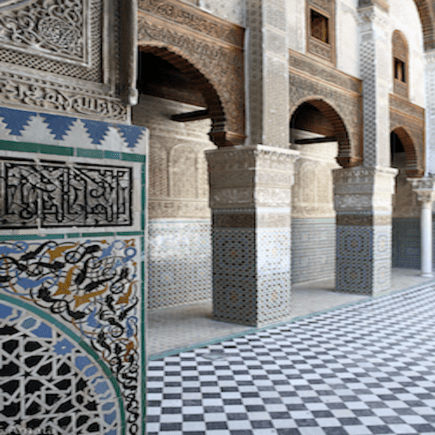
3. Al-Attaraine Madrasa (Fes, Medina)
This 17th-century madrasa is well-appointed in front of the spice and perfume market in Fes. The courtyard of this historic madrasa is ornately decorated with traditional patterns and craftsmanship of the Marinid dynasty. The Al-Attarine Madrasa’s walls are decorated with hand-carved stucco work, Arabic calligraphy, and intricate zellige mosaic tiles. The zellige tiles form magnificent Islamic geometric patterns. The cedarwood doors are intricately carved with poetic words of the Quran on them.
Visitors can marvel at the exceptionally tall carved marble columns rise from the floor and the cedarwood doors that intricately carved with poetic words from the Quran. Elaborate wood arches and cornices tower above towards the sky. The Al Attarine Madrasa takes its name from “Souk al-Attarine – the historic spice and perfume market in UNEXO Fes”.
4. Ben Youssef Medersa (Marrakech Medina)

5. El Bahia Palace (Marrakech Medina)

6. La Tangerina Boutique Hotel, Traditional Courtyard Fountain with Arabesque & Tessellated Patterns (Tangier Medina)
7. Moulay Ismail, Mausoleum (Meknes, Medina)
8. Saadian Tombs (Marrakech, Medina)
The Saadian tombs in Marrakech date back from the time of the sultan Ahmad al-Mansur (1578-1603). The tombs were only recently discovered (in 1917) and were restored by the Beaux-arts service. The tombs have, because of the beauty of their decoration, been a major attraction for visitors of Marrakech. The mausoleum comprises the corpses of about sixty members of the Saadi Dynasty that originated in the valley of the Draa River.
9. The Batha Museum & Garden (Fes, Medina)
The Musee Dar el-Batha offers up a great collection of pottery, leatherwork, wood, books, and manuscripts from the nineteenth century centered around a green spacious courtyard. The Batha Andalusian Garden boasts a three-hundred-year-old Quercus Rotundifolia, Washington Fiera, Cycas Revolta, and Moroccan fountains. The Batha Garden is a serene escape from the bustling medina in Fes. It is also utilized each June by the Fes Festival of Sacred World Music where various world music groups perform.
10. Cherratin Madrasa (Fes, Medina)

11. Kasbah Taourirt, El Glaoui Kasbah (Ouarzazate)
Set among a background of the stunning mountain scenery of Ouarzazate, the door to the Sahara Desert, Kasbah Taourirt is one of Southern Morocco’s Kasbah with a rich history and ideal example of Islamic architecture that has geometric patterned zellige tilework. In the past, it was a strategic location controlled by the Glaoui for the Saharan Caravan Route to West Africa. While Taourirt acted as the main Glaoui residence, it did not house the main Glaoui chiefs. Instead, it housed the second tier of command, such as the dynasty’s sons, servants, cousins, builders, and craftsmen. The maze-like structure inside Taourirt is best described as a cobweb village of sun-kissed buildings with multi-level, elaborate towers and turrets rising out of closely packed ksours.
It has ramparts with geometrical drawings and a series of alleys and gateways. There are more than twenty riads, that makeup Taourirt. Inside the Kasbah Taourirt, there is a myriad of mysterious stairwells leading into a series of uniquely shaped and sized rooms lit up by low windows. The larger rooms have plasterwork decoration featuring floral patterns and are contrasted against white walls. The palace has close to three hundred rooms. It is also possible to visit old Glaoui apartment rooms such as the former reception rooms, harem room, and palace kitchens. The apartments are distinguished by well-preserved painted stucco and wooden cedar ceilings.
